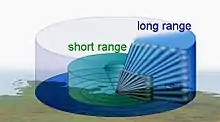AN/SPY-3
The AN/SPY-3 is an active electronically scanned array radar manufactured by Raytheon and designed for both blue-water and littoral[1] operations.
| Designation | Ship types | Function |
|---|---|---|
| AN/SPY-1 | Ticonderoga class cruisers, Arleigh Burke class destroyers | Anti-air, Ballistic Missile Defense |
| AN/SPY-3 | Zumwalt-class destroyers, Gerald R. Ford-class aircraft carriers | High-volume search |
| Country of origin | United States |
|---|---|
| Type | Navigation/Targeting |
| Frequency | X band |
| Range | 200 mi (320 km) |
Ancestry
The Aegis battle management system began with the AN/SPY-1 Passive electronically scanned array radar, intended to deal with an aircraft threat. Later repurposed to allow for Ballistic Missile Defense search and track.
Technology

X band functionality (8 to 12 GHz frequency range) is optimal for minimizing low-altitude propagation effects, narrow beam width for best tracking accuracy, wide frequency bandwidth for effective target discrimination, and the target illumination for SM-2 and Evolved Sea Sparrow Missiles (ESSM). The X-band has, in general, favorable low-altitude propagation characteristics, which readily support the horizon search functionality of the AN/SPY-3. A large operating bandwidth is required to mitigate large propagation variations due to meteorological conditions.
The system uses commercial off the shelf (COTS) computers and has reduced manning requirements for operation and maintenance. A number of operation and maintenance functions can be completely automated. Commercial IBM Regatta series symmetric multiprocessor (SMP) servers, ruggedized for the shipboard environment, provide the low-latency computing throughput (rapid sensor-to-shooter loop closure) and high productivity software engineering environment.[3]
The AN/SPY-3 was originally to be combined with the S Band AN/SPY-4 under the designator "Dual Band Radar" on both the Zumwalt Class (DDG-1000) destroyer and Ford Class (CVN-78) aircraft carrier. On 2 June 2010, Pentagon acquisition chief Ashton Carter announced that they will be removing the SPY-4 S-band Volume Search Radar from the DDG 1000's dual-band radar to reduce costs as part of the Nunn-McCurdy certification process. Due to the SPY-4 removal, SPY-3 radar is to have software modifications so as to perform a volume search functionality. Shipboard operators will be able to optimize the SPY-3 MFR for either horizon search or volume search. While optimized for volume search, the horizon search capability is limited. Without the VSR, DDG-1000 is still expected to perform local area air defense. The Ford Class aircraft carriers will be the only platforms to have both radars married in one system.[4]
Deployment
The system will be introduced in the new Zumwalt-class destroyers and Gerald R. Ford-class aircraft carriers. It is also under consideration for retrofit to existing ships (USS Makin Island (LHD-8), Nimitz-class aircraft carriers, and San Antonio-class amphibious transport docks. Other installation candidates are the LH(X) future ship class.[1]
See also
References
- Pike, John. "AN/SPY-3 Multi-Function Radar (MFR)".
- "Archived copy" (PDF). Archived from the original (PDF) on 2015-09-23. Retrieved 2014-11-03.CS1 maint: archived copy as title (link)
- https://fas.org/sgp/crs/weapons/RL32109.pdf
